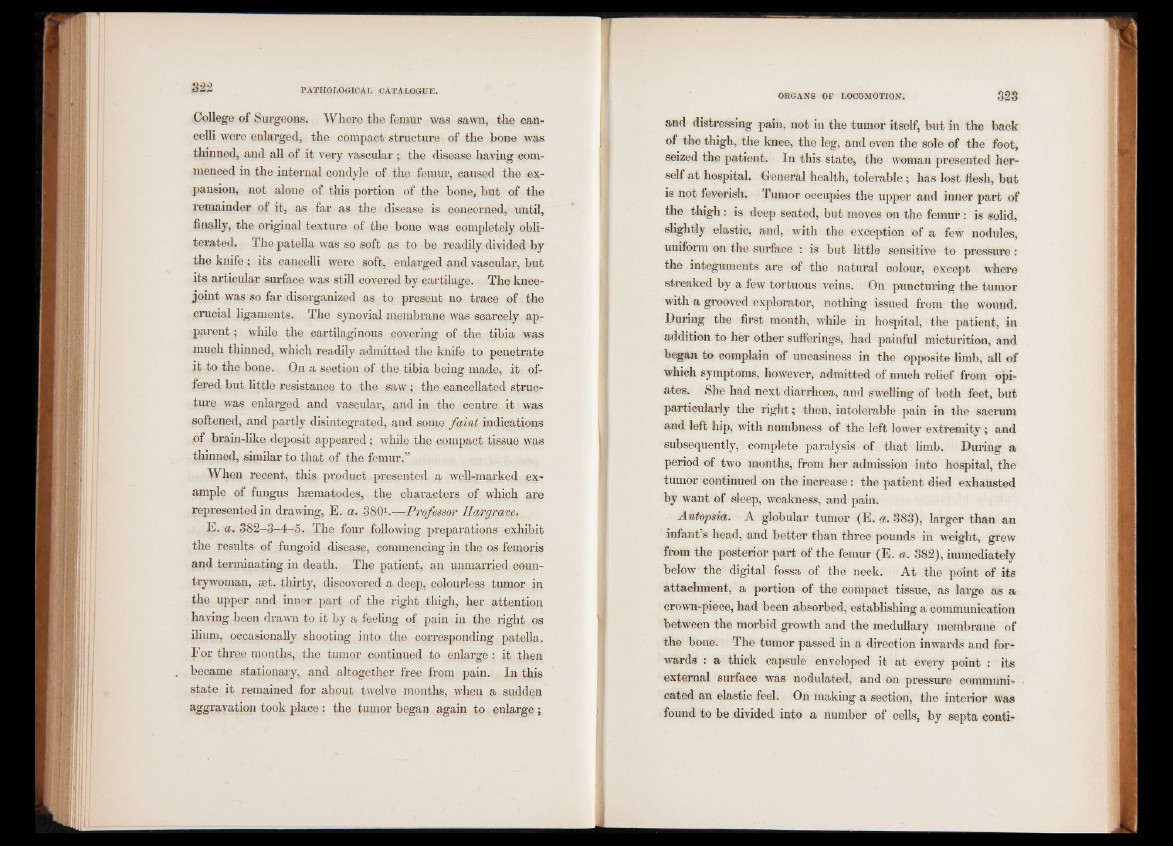
College of Surgeons. Where the femur was sawn, the can-
celli were enlarged, the compact structure of the bone was
thinned, and all of it very vascular ; the disease having commenced
in the internal condyle of the femur, caused the expansion,
not alone of this portion of the bone, but of the
remainder of it, as far as the disease is concerned, until,
finally, the original texture of the bone was completely obliterated.
The patella was so soft as to be readily divided by
the knife ; its cancelli were soft, enlarged and vascular, but
its articular surface was still covered by cartilage. The knee-
joint was so far disorganized as to present no trace of the
crucial ligaments. The synovial membrane was scarcely apparent
; while the cartilaginous covering of the tibia was
much thinned, which readily admitted the knife to penetrate
it to the bone. On a section of the tibia being made, it of-
fered but little resistance to the saw; the cancellated structure
was enlarged and vascular, and in the centre it was
softened, and partly disintegrated, and some faint indications
of brain-like deposit appeared; while the compact tissue was
thinned, similar to that of the femur.”
When recent, this product presented a well-marked example
of fungus hsematodes, the characters of which are
represented in drawing, E. a. 3801.—Professor Hargrave,
E. a. 382—3—4—5. The four following preparations exhibit
the results- of fungoid disease, commencing in the os femoris
and terminating in death. The patient, an unmarried countrywoman,
get. thirty, discovered a deep, colourless tumor in
the upper and inner part of the right thigh, her attention
having been drawn to it by a feeling of pain in the right os
ilium, occasionally shooting into the corresponding patella.
For three months, the tumor continued to enlarge: it then
became stationary, and altogether free from pain. In this
state it remained for about twelve months, when a sudden
aggravation took place: the tumor began again to enlarge ;
and distressing pain, not in the tumor itself, but in the back
of the thigh, the knee, the leg, and even the sole of the foot,
seized the patient. In this state, the woman presented herself
at hospital, General health, tolerable; has lost flesh, but
is not feyerish. Tumor occupies the upper and inner part of
the thigh: is deep seated, but moves on the femur: is solid,
slightly elastic, and, with the exception of a few nodules,
uniform on the surface : is but little sensitive to pressure:
the integuments are of the natural colour, except where
streaked by a few tortuous veins. On puncturing the tumor
with a grooved explorator, nothing issued from the wound.
During the first month, while in hospital, the patient, in
addition to her other sufferings, had painful micturition, and
began to complain of uneasiness in the opposite limb, all of
which symptoms, however, admitted of much relief from opiates.
She had next diarrhoea, and swelling of both feet, but
particularly the right; then, intolerable pain in the sacrum
and left hip, with numbness of the left lower extremity ; and
subsequently, complete paralysis of that limb. During a
period of two months, from her admission into hospital, the
tumor continued on the increase: the patient died exhausted
by want of sleep, weakness, and pain.
Autopsia. A globular tumor (E. a. 383), larger than an
infant s head, and better than three pounds in weight, grew
from the posterior part of the femur (E. a. 382), immediately
below the digital fossa of the neck. At the point of its
attachment, a portion of the compact tissue, as large as a
crown-piece, had been absorbed, establishing a communication
between the morbid growth and the medullary membrane of
the bone. The tumor passed in a direction inwards and forwards
: a thick capsule enveloped it at every point : its
external surface was nodulated, and on pressure communicated
an elastic feel. On making a section, the interior was
found to be divided into a number of cells, by septa conti